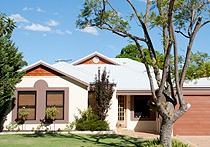Older Australians living large
Many older Australians are living in large homes that could be considered under-utilised but almost none want to downsize, UNSW researchers have found.
Many older Australians are living in large homes that could be considered under-utilised but almost none want to downsize, UNSW researchers have found.

Many older Australians are living in large homes that would be considered under-utilised by international standards but almost none want to downsize, UNSW researchers have found.
A study led by Associate Professor Bruce Judd of the City Futures Research Centre found 84 percent of homes - typically three-bedroom residences on large suburban blocks - occupied by Australians aged 55 and over would be considered too big by international occupancy standards.
Yet more than 90 percent of this group wanted to remain in their homes, supported by professional services, rather than move to smaller premises such as retirement villages.
"Most older Australians don't believe they're living in homes that are too large," Associate Professor Judd said.
"They feel that their homes are of a suitable size and are well utilised with extra rooms given over to hosting permanent residents, visiting friends and family, home offices and hobbies."
The national study of 1604 older homeowners found that while most people preferred to remain in their own homes, 63 per cent were prepared to consider entering a retirement village in the event of developing a disability or increased need for assistance, whilst 56 per cent were prepared to enter a development for seniors in such circumstances. However, only 18 per cent would consider moving in with their children.
Associate Professor Judd said most older Australians want to have a home that can be easily modified at low-cost to meet their needs, or a universally designed home that does not need to be modified. However, for those needing to move to more appropriately designed housing, having a choice of options available is also important.
"Many older Australians are nervous about retirement villages citing lifestyle issues, cramped living quarters, bad experiences reported by others and concern about the cost," Associate Professor Judd said.
The study was conducted for the Australian Housing and Urban Research Institute (AHURI).
AHURI executive director Dr Winter said older Australians need to be supported to make changes before their abilities decline.
"We need to provide attractive and diverse housing options for older people within their neighbourhoods and eliminate financial disincentives to moving such as stamp duties," Dr Winter said.
"But because people prefer to stay where they are, there's a strong case to be made for regulating housing design to make it age-friendly right from the start, to eliminate or at least minimise the need to make modifications later."
Related links: City Futures Research Centre
Media Contacts:Associate Professor Bruce Judd | 02 9385 5274 | b.judd@unsw.edu.au
Peter Trute, UNSW Media Office | 02 9385 1933 | p.trute@unsw.edu.au